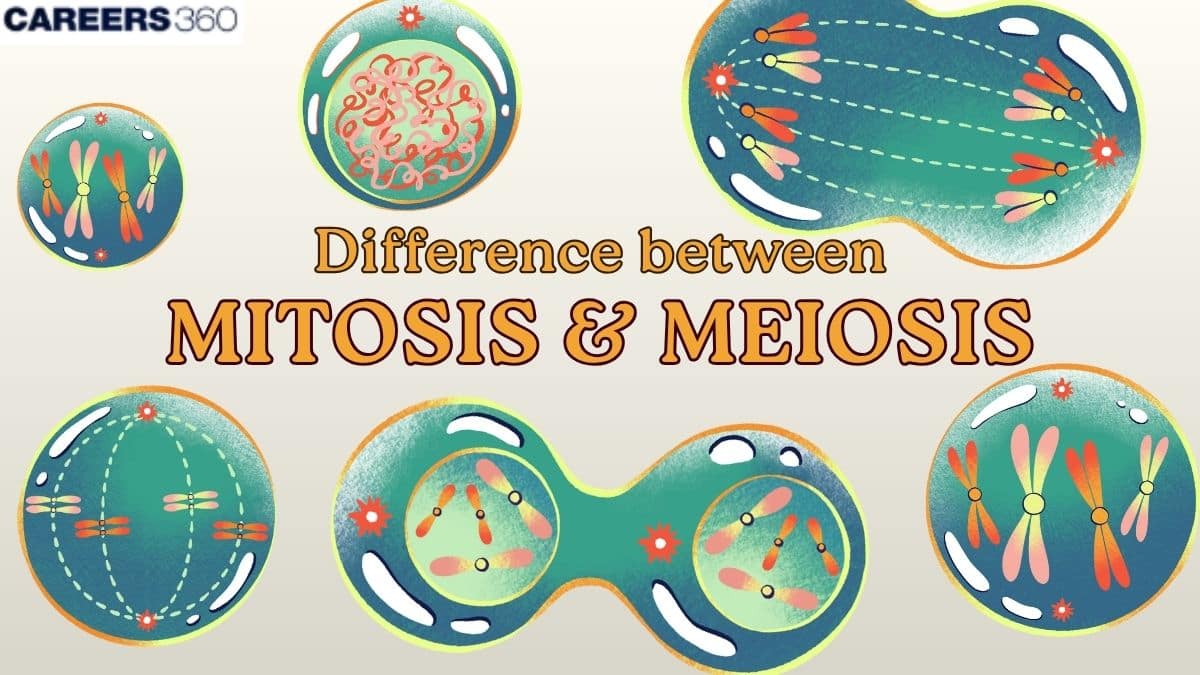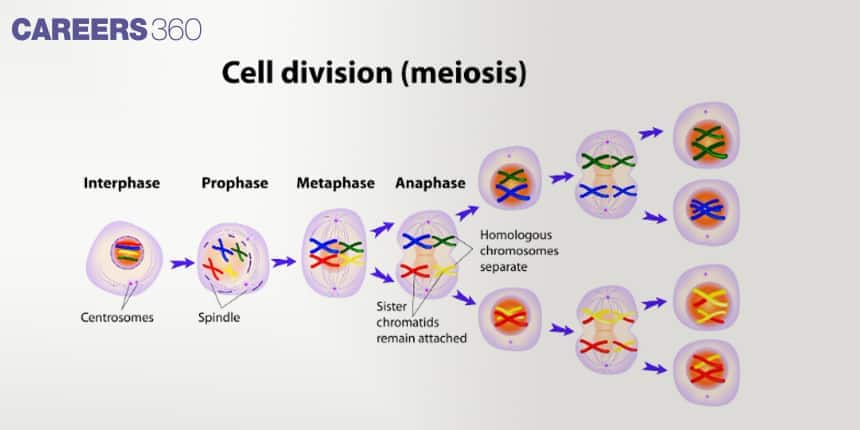Difference Between Mitosis And Meiosis: Overview, Diagram
Mitosis and meiosis are two fundamental types of cell division. Mitosis produces identical diploid cells for growth and repair, while meiosis produces haploid gametes for sexual reproduction and genetic diversity. Understanding their differences is essential for NEET and Class 11 Biology.
This Story also Contains
- Introduction
- What is Mitosis?
- What is Meiosis?
- Genetic Recombination and Crossing Over
- Differences Between Mitosis And Meiosis
- Similarities Between Mitosis and Meiosis
- Significance of Mitosis and Meiosis
- Mitosis vs Meiosis NEET MCQs (With Answers & Explanations)

Introduction
Cell division is a basic process by which the organism is continuously developed, grown, and repaired. There are two major types of cell division: mitosis and meiosis. Both processes involved in cell division hold a significant part in the life of organisms, which is a potent tool for growth, reproduction, and adaptation.
Overview of Cell Division
Cell division is a process where one parent cell divides into two or more daughter cells. It is the most crucial process for all living organisms and deals with the growth, repair, and reproduction of the organism irrespective of its type.
Mitosis is the process by which one cell (mother cell) becomes two daughter cells. Meiosis is defined as a special kind of cell division that reduces the number of chromosomes. It is the process by which one diploid cell gets differentiated into four genetically different haploid cells.
Importance of Mitosis and Meiosis in Life Continuity
Mitosis and meiosis are two major processes of cell division that give continuity to life and genetic diversity. It is here that mitosis produces identical cells with a similar type needed for growth and repair. At the same time, meiosis produces genetically unique gametes for sexual reproduction.
What is Mitosis?
Mitosis is the kind of cell division whereby a cell divides itself to give rise to two identical daughter cells that are made up of the exact nuclear complement of their parental cell. This, therefore, is important in multicellular organisms, relating to aspects of growth, development, and tissue repair.
Phases of Mitosis (Prophase, Metaphase, Anaphase, Telophase)
The mitosis is divided into four sub-phases: prophase, metaphase, anaphase, and telophase and upon completion of which is cytokinesis.
Prophase
The chromatin condenses and the chromosomes are visible.
The nucleolus disappears and the nuclear envelope disintegrates.
With the disappearance of the nuclear membrane, the centrioles migrate to the opposite end and the spindle formation occurs.
During late prophase or prometaphase, kinetochores appear on each side of the centromere.
Metaphase
Chromosomes become fully condensed and move towards the equatorial plane of spindles or metaphase plates.
The arms of chromosomes are directed towards the pole and centromere towards the equator.
Anaphase
The centromere splits and the two chromatids of the duplicated chromosomes separate from each other.
Each chromatid now becomes a daughter chromosome and moves toward opposite poles.
Telophase
During this phase, the spindle disappears and new nuclear envelopes develop around the daughter chromosomes.
Each daughter nucleus contains the same number and kinds of chromosomes as the original parent cell.
The chromosomes become diffuse chromatin and nucleolus reappears.

Cytokinesis in Plant and Animal Cells
In animal cells, cytokinesis is distinguished by the formation of a cleavage furrow and this pinches the cell into two daughter cells.
The plant cells in the process of cytokinesis initiate a cell plate at the equator of the dividing cell that later on differentiates into a new cell wall, which is found separating the daughter cells.
What is Meiosis?
Meiosis is a specialised cell division that reduces the number of chromosomes to half in each cell formed to produce four so-called haploid genetically diverse cells. In most sexually reproducing organisms, meiosis consists of two successive divisions: meiosis I and meiosis II. It enables sexual reproduction and produces genetic diversity. It also maintains the number of chromosomes from generation to generation in sexually reproducing organisms.
Meiosis I (Prophase I, Metaphase I, Anaphase I, Telophase I)
Meiosis I consists of:
Prophase I: The pairing of the homologous chromosomes occurs and exchange their genetic materials through a process called crossing over.
Metaphase I: Consists of having these pairs at the metaphase plate.
Anaphase I: The homologous chromosomes are separated into opposite poles.
Telophase I: The cell is divided into two haploid cells.
Meiosis II (Prophase II, Metaphase II, Anaphase II, Telophase II)
Meiosis II resembles mitosis:
Prophase II: Once again compacted chromatin appears.
Metaphase II: The chromosomes align at the metaphase plate.
Anaphase II: The sister chromatids once again come to opposite poles.
Telophase II: It ends with the formation of four genetically different haploid cells.

Genetic Recombination and Crossing Over
Genetic recombination and crossing over take place in Prophase I of meiosis I, when the homologous chromosomes are paired and segments of genetic material are exchanged. This shuffling of genes between the chromosomes is known as crossing over. It leads to genetic diversity as it generates genetically variant gametes hence adding up to variations for a particular species.
Differences Between Mitosis And Meiosis
The essential differences among the phases of mitosis and meiosis are as follows:
Feature | Mitosis | Meiosis |
Type of Division | Equational | Reductional |
Daughter Cells | Two identical daughter cells are formed | Four genetically diverse cells are produced. |
Function | Important for growth and proper body function | It is crucial for sexual reproduction. |
Number of Divisions | Two daughter cells are formed from one division. | Four daughter cells are formed from two divisions. |
Chromosome Number | The chromosome number is same as that of parents (2n) | The chromosome number is half of parents (n). |
Crossing Over | It is absent. | It is present and occurs in prophase I of meiosis I. |
Example | It occurs in somatic cells such as skin cells. | It occurs in germ cells such as sperm and egg. |
Similarities Between Mitosis and Meiosis
Although mitosis and meiosis are different but they share a few similarities, like:
Involvement of DNA Replication
Before division, both mitosis and meiosis involve a single round of DNA replication during the interphase.
Presence of M-Phase Stages
Both the processes include the basic phases of the cell cycle: prophase, metaphase, anaphase and telophase. Both the processes culminate in the division of the cytoplasm to form daughter cells.
Role in Life Continuity
Both mitosis and meiosis play vital roles in maintaining the continuity of life. Mitosis ensures growth, repair, and replacement of cells, while meiosis produces gametes that preserve the chromosome number across generations.
Significance of Mitosis and Meiosis
The significance of mitosis and meiosis includes:
Mitosis – Growth, Repair and Asexual Reproduction
Mitosis results in the development of multicellular organisms. As they begin their life as a unicellular zygote, it undergoes divisions to form a multicellular embryo that gives rise to a whole organism.
In multicellular organisms, mitosis helps in growth and repair. Whereas, in unicellular organisms, mitosis results in cell division.
Mitosis enables asexual reproduction by producing genetically identical daughter cells from a single parent cell. This ensures growth and continuity of genetic information in unicellular and multicellular organisms.
Meiosis – Genetic Diversity and Evolutionary Advantage
Meiosis is essential in providing genetic variation. Through crossing over processes during prophase I and independent assortment in metaphase I, leads to specific sets of genetic materials that form the gametes.
Meiosis causes evolution through the creation of genetically diverse haploid gametes. This creates diversity so that offspring may inherit unique combinations of genotypes from their parents.
Additionally, meiosis is required for sexual reproduction since it creates gametes with half the number i.e., the haploid number of chromosomes.
Mitosis vs Meiosis NEET MCQs (With Answers & Explanations)
Important topics for NEET exam are:
Phases of Mitosis and Meiosis
Mitosis vs Meiosis
Practice Questions for NEET
Q1. Mitosis is characterised by
Reduction division
Both reduction and equational division
Equal division
Pairing of homologous chromosomes
Correct answer: 3) Equal division
Explanation:
The process of cell division known as mitosis produces two identical daughter cells when the chromosomes duplicate and are distributed equally. Each daughter cell has the same number of chromosomes as the parent cell, making them diploid. Consequently, the process of mitosis is referred to as equal division.
Hence, the correct answer is the option 3) Equal division.
Q2. The significance of meiosis lies in
Reduction of the diploid number of chromosomes to haploid
Maintaining constancy in the number of diploid chromosomes during sexual reproduction
Production of genetic variability in the population of a species
All of these
Correct answer: 4) All of these
Explanation:
Meiosis II occurs in haploid cells where each chromosome still consists of duplicated sister chromatids, which are separated during this phase, resulting in haploid cells with single chromatids. The significance of meiosis lies in reducing the diploid chromosome number to haploid, ensuring constancy of chromosome numbers across generations during sexual reproduction, and generating genetic variability through crossing over and independent assortment. This variability plays a key role in evolution, while meiosis also enables the formation of haploid gametes (sperms and ova), essential for sexual reproduction in organisms.
Hence the correct answer is option 4) All of these.
Q3. During the metaphase stage of mitosis , spindle fibres attach to chromosomes at
Kinetochore
Both centromere and kinetochore
Centromere
Centromere, kinetochore and area adjoining Centromere
Correct answer: 1) Kinetochore
Explanation:
Chromosomes - During different stages of cell division, cells show structured chromosomes in places of the nucleus. Every chromosome essentially has a primary constriction or the centromere on the sides of which disc-shaped structures called kinetochores are present. A kinetochore is a complex protein structure where microtubes attach themselves to the chromosomes.
Hence, the correct answer is option 1) Kinetochore.
Also Read:
Frequently Asked Questions (FAQs)
It can be noted that mitosis produces two daughter cells that are identical to one another for growth and repair, whilst meiosis develops four gametes which are genetically diverse and meant for sexual reproduction.
While mitosis is a single, meiosis is a double division and hence yields four daughter cells. Consequently, as a result of mitosis, there remain two daughter cells.
This helps increase variation, thus the process of evolution and adaptation.
Both have the prophase, metaphase, anaphase, and telophase stages; both are cell division.
Errors in meiosis, such as nondisjunction, can cause some genetic disorders due to an abnormal number of chromosomes, as in Downs syndrome.